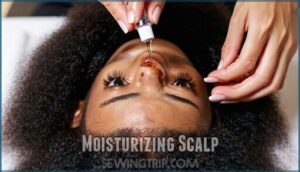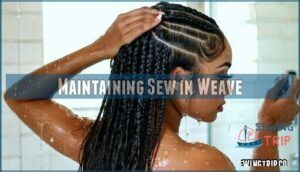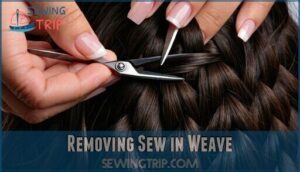This site is supported by our readers. We may earn a commission, at no cost to you, if you purchase through links.
 Learning how to wash a sew in properly starts with diluting sulfate-free shampoo in a spray bottle, creating a gentle cleansing solution that won’t strip your natural hair or damage the tracks.
Learning how to wash a sew in properly starts with diluting sulfate-free shampoo in a spray bottle, creating a gentle cleansing solution that won’t strip your natural hair or damage the tracks.
You’ll focus on your scalp, using fingertips to massage in circular motions while avoiding aggressive scrubbing that could loosen the wefts. Always wash in downward strokes, never upward, which prevents the dreaded matting that turns your beautiful weave into a tangled mess.
Rinse thoroughly with lukewarm water, then apply conditioner from mid-length to ends only.
The real game-changer lies in your drying technique and the specific products that extend your weave’s lifespan substantially, which can make a significant difference in the overall health and appearance of your beautiful weave, and help prevent tangled mess, by using the right gentle cleansing solution.
Table Of Contents
Key Takeaways
- Use the right shampoo technique – You’ll want to dilute sulfate-free shampoo in a spray bottle and focus on massaging your scalp with fingertips in circular motions, avoiding aggressive scrubbing that could loosen the wefts.
- Wash in the correct direction – Always wash your weave in downward strokes, never upward, to prevent matting and tangling that can turn your beautiful weave into a mess.
- Apply conditioner strategically – You should only apply conditioner from mid-length to ends, completely avoiding your scalp to prevent buildup and maintain proper moisture balance.
- Maintain proper washing frequency – You’ll need to wash your sew-in every 7-10 days, depending on your activity level and hair type, balancing cleanliness with protection to extend your weave’s lifespan.
Preparing Sew in Weave
You’ll need to gather essential supplies before washing your sew-in weave, including sulfate-free shampoo, moisturizing conditioner, a wide-tooth comb, and a soft microfiber towel, as proper preparation prevents tangling and guarantees thorough cleaning without damaging the hair extensions or your natural hair underneath.
Proper preparation with the right tools prevents damage and ensures your sew-in weave stays healthy and beautiful longer.
This preliminary step, which takes about five minutes, sets the foundation for maintaining healthy hair and extending your weave’s lifespan through strategic product selection and tool preparation, ultimately leading to a longer and more maintained weave, by using the right microfiber towel.
Choosing Right Shampoo
When selecting the best shampoo sew in for your weave, sulfate concerns should top your priority list.
Sulfatefree shampoo prevents excessive drying while maintaining pH balance essential for both your natural hair and extensions.
Through careful ingredient analysis, choose formulas that match your specific hair type, whether you need gentle cleansing or clarifying shampoos to wash sew in effectively without damaging delicate tracks.
Some shampoos, like coconut milk shampoo, are known for their moisturizing and strengthening properties.
Conditioning Techniques
After choosing your sulfate-free shampoo, proper sew in conditioner application becomes your weave’s lifeline.
Apply deep conditioning treatments from mid-length to ends, avoiding your scalp entirely. Leave-in conditioners provide daily moisture, while protein treatments strengthen your sew in hair weekly.
For a natural look, select extensions that closely match your hair or blend shades, and you can also explore different types of hair extensions.
Oil rinsing with lightweight formulas enhances shine without weighing down your extensions during sew in maintenance routines.
Detangling Methods
Gentle detangling protects your sew in hair from unnecessary breakage and maintains its longevity.
Start with dry detangling using a wide-tooth comb on each section, then move to wet detangling after applying leave-in conditioner.
Your product choice and tool selection directly impact your sew in maintenance routine.
- Sectioning Hair: Divide extensions into manageable parts for thorough cleaning sew in processes
- Wet Detangling: Apply detangling spray before combing through damp washing hair extensions
- Dry Detangling: Remove surface tangles gently before your sew in hair care routine begins
Washing Sew in Weave
Now that your weave is prepped and ready, it’s time to master the actual washing technique. Start by wetting your hair with lukewarm water temperature – hot water can damage both your natural hair and extensions. Apply sew in shampoo directly to your scalp, working it through with gentle circular motions.
Master the art of gentle washing – your weave and natural hair will thank you for the tender care.
Don’t scrub aggressively; this creates tangles and product buildup that’s tough to remove later. Focus on cleaning sew in tracks thoroughly, as this area traps the most dirt and oils. When washing hair extensions, work the shampoo down the length using a squeezing motion rather than rubbing.
This sew in hair care approach prevents matting while ensuring cleanliness. To extend the lifespan, consider proper braiding techniques. Rinse completely – leftover residue causes weave odor and scalp irritation.
The key to how to clean sew in weaves effectively lies in patience. Take your time during the rinsing process, as proper drying time starts with thorough cleansing.
Scalp Care Tips
Your scalp needs consistent attention throughout your sew-in installation, as neglecting proper care can lead to dryness, irritation, and potential hair damage beneath the weave.
You’ll maintain healthy scalp health by implementing targeted moisturizing techniques, addressing itchiness promptly, and creating conditions that support your natural hair’s growth cycle while the extensions remain securely in place, which is crucial for overall hair damage prevention.
Moisturizing Scalp
After cleaning your sew in weave, maintaining proper scalp hydration becomes your next priority.
Dry scalp underneath extensions can lead to uncomfortable tension and flaking that affects your entire look.
Focus on these moisturizing essentials:
- Apply lightweight oils like jojoba or argan directly to your scalp using an applicator bottle
- Use a moisturizing conditioner during weekly washes to prevent dryness
- Gently massage your scalp to stimulate circulation and distribute natural oils, which helps in maintaining a healthy scalp.
Reducing Itchiness
Itchy scalp during your sew in weave journey often stems from product buildup or tight braids restricting airflow.
Combat scalp irritation by diluting tea tree oil with water, then gently applying to affected areas. Witch hazel works wonders for soothing remedies too.
To prevent further irritation, consider gentle scalp soothers for relief. When learning how to clean sew in installations, remember that proper scalp care and sew in maintenance prevents most itching issues before they start, which is a key part of a sew in weave journey.
Promoting Hair Growth
Beyond addressing itchiness, your sew in routine becomes a powerful tool for accelerating natural hair growth underneath. Growth oils like castor or rosemary oil nourish follicles during scalp massage sessions, while maintaining a healthy diet rich in biotin intake supports internal hair development.
This protective styling method creates ideal conditions for robust growth.
- Weekly scalp massage with growth oils stimulates blood circulation and promotes follicle health
- Biotin-rich foods like eggs and nuts provide essential nutrients for stronger hair development
- Gentle cleansing routine prevents buildup that can block follicles and inhibit growth
- Consistent moisture balance keeps both scalp and natural hair in peak growing condition
Maintaining Sew in Weave
You’ll need to establish a consistent maintenance routine that balances cleanliness with protection, since overwashing can strip natural oils while underwashing allows buildup to damage both your weave and natural hair underneath.
The key lies in understanding proper washing frequency, implementing damage-prevention techniques, and selecting styling methods that won’t compromise the integrity of your sew-in installation.
Washing Frequency
Finding your perfect washing rhythm depends on several key factors that affect your sew in’s longevity.
Your activity level, hair type, and product buildup determine how often you’ll need to cleanse for ideal scalp care sew in maintenance.
| Factor | Wash Every | Notes |
|---|---|---|
| Low Activity/Dry Hair | 10-14 days | Minimal product buildup, gentle sew in routine |
| Moderate Activity/Normal Hair | 7-10 days | Standard healthy sew in schedule, seasonal washing adjustments |
| High Activity/Oily Hair | 5-7 days | Prevents sew in itching, manages excess oils effectively |
| Heavy Product Use | 5-7 days | Combat sew in products accumulation, maintain scalp health |
The perfect washing rhythm is crucial for maintaining a healthy sew in, and understanding these factors can help you develop a sew in routine that meets your specific needs.
Avoiding Damage
Your healthy sew in depends on preventing damage before it starts.
Monitor sew-in tightness regularly, as overly tight installations cause breakage and scalp irritation.
Use friction reduction techniques like silk pillowcases for night protection, and avoid excessive heat styling that weakens both your natural hair and extensions.
Many people find silk reduces friction on their hair.
Address product buildup weekly through gentle cleansing to maintain ideal scalp care sew in health.
Styling Options
Your sew-in weave opens doors to countless styling possibilities that’ll keep your look fresh and exciting.
From sleek updos to trendy braid styles, you can experiment with different textures and lengths while maintaining proper hygiene practices.
Here are five versatile styling options:
- Heat Styling Transformations – Create bouncy curls or pin-straight looks using heat protectant products
- Protective Styles – Try low-manipulation braids and twists that promote scalp care sew in maintenance
- Elegant Updo Ideas – Perfect for formal events, from sophisticated buns to intricate braided crowns
- Bold Color Options – Experiment with vibrant hues without damaging your natural hair underneath
- Mixed Textures – Combine straight and curly pieces for dynamic, eye-catching styles
Remember to follow proper sew in tutorial guidelines and maintain good hygiene to prevent any sew in smell issues while exploring these creative possibilities.
To avoid damage, remember to wash your weave weekly.
Removing Sew in Weave
When it’s time to remove your sew-in weave, you’ll need patience, proper tools, and gentle techniques to protect both your natural hair and the weave extensions for potential reuse.
The removal process requires careful attention to each thread, systematic cutting of the weft attachments, and thorough detangling to prevent breakage, damage, or unnecessary hair loss during this critical phase, which demands gentle techniques.
Gentle Removal Methods
When it’s time to say goodbye to your sew-in, patience becomes your best friend.
Start with careful thread cutting using small scissors, then focus on knot loosening around each weft. For tracks with adhesive, use gentle dissolving solutions to prevent extension slippage during natural separation.
| Removal Step | Best Practice |
|---|---|
| Thread Cutting | Use small, sharp scissors at 45-degree angle |
| Knot Loosening | Work from bottom up, never pull forcefully |
| Adhesive Dissolving | Apply oil-based remover, wait 10 minutes |
| Natural Separation | Gently slide extensions down, avoid tugging |
Reusing Weave Tips
Quality extensions deserve a second chance if you’ve mastered proper cleaning methods during removal.
Smart reapplication process decisions can maximize your investment while maintaining personal hygiene standards.
Consider these weave longevity factors before reusing:
- Assess hair texture – Extensions maintaining original softness indicate quality retention potential
- Examine weft integrity – Secure stitching prevents future shedding and infectious disease prevention concerns
- Calculate cost savings – Hand washing with gentle soap extends lifespan substantially
Post Removal Hair Care
After successfully removing your weave, your natural hair needs immediate attention to restore its health and vitality.
Begin with scalp soothing treatments to reduce irritation, followed by deep conditioning for damage repair and moisture retention. One should also consider using necessary tools and supplies to make the process easier.
Focus on hair strengthening routines that promote growth stimulation while maintaining proper hygiene practices for personal hygiene and health education that’s of the utmost importance.
| Treatment Type | Purpose |
|---|---|
| Deep Conditioning | Moisture retention and damage repair |
| Scalp Massage | Growth stimulation and circulation |
| Protein Treatment | Hair strengthening and structure |
| Oil Treatment | Scalp soothing and nourishment |
Proper behavioural practices during this recovery phase guarantee your hair returns stronger than before.
Frequently Asked Questions (FAQs)
How often should I wash my sew-in weave?
Most stylists recommend washing your sew-in every 7-10 days to maintain scalp health.
You’ll want to focus on cleansing your natural hair underneath while being gentle with the extensions to prevent tangling and preserve longevity.
What products or tools can help me wash and detangle my weave?
You’ll need sulfate-free shampoo, moisturizing conditioner, a wide-tooth comb, and microfiber towels.
These gentle products prevent tangling while cleansing effectively.
Don’t forget detangling spray and leave-in conditioner for extra protection during your wash routine.
My scalp is really itchy under the weave. What can I do for relief?
Like fire ants marching under a blanket, that itch demands immediate attention.
You’ll find relief by gently massaging diluted tea tree oil onto your scalp, using a cotton swab to reach between tracks without disturbing the weave’s foundation.
How do I prevent frizz and dryness with my weave?
Use a lightweight leave-in conditioner on your weave weekly, sleep with a silk pillowcase, and avoid excessive heat styling.
Keep your natural hair moisturized underneath, and gently detangle with wide-tooth combs only.
Can I swim with sew-in extensions?
Making waves in chlorinated waters can turn your gorgeous locks into a tangled mess.
You can swim with sew-in extensions, but protect them with a swimming cap, rinse immediately afterward, and deep condition to prevent damage.
How long should sew-ins stay installed?
Sew-in extensions should typically stay installed for 6-8 weeks maximum.
You’ll want to remove them sooner if you notice excessive tangling, matting, or scalp irritation to maintain your natural hair’s health.
What sleeping position protects sew-in weave?
Sleep on your back or side with a silk pillowcase to minimize friction.
You’ll want to wrap your hair in a silk scarf or bonnet, keeping the weave smooth and preventing tangles that damage your investment.
Should I blow dry sew-in hair?
You can blow dry your sew-in, but heat protection’s essential.
Keep the dryer on cool or low heat, maintain six inches distance, and don’t overdo it—your natural hair underneath needs gentle care.
Can heat styling damage sewn tracks?
Like a delicate silk scarf exposed to scorching sun, your sewn tracks can suffer irreversible damage from excessive heat.
Yes, high temperatures weaken the thread, loosen attachment points, and degrade hair quality, potentially ruining your investment.
Conclusion
Statistics show that properly maintained sew-in weaves can last up to eight weeks when washed correctly.
Mastering how to wash a sew in requires patience, the right products, and gentle techniques that preserve both your natural hair and the weave’s integrity.
You’ve learned that diluted sulfate-free shampoo, downward washing motions, and proper drying methods are essential for preventing damage.
With consistent care and these proven techniques, your sew-in will maintain its beautiful appearance throughout its lifespan, using the right methods to preserve its integrity.
- https://naturalistavibes.com/sew-ins-for-natural-hair-growth/
- https://www.hermosahair.com/blogs/blog/sew-in-vs-quick-weave
- https://www.rchairsolutions.com/blog/2018/6/11/5-ways-to-grow-your-hair-whilst-wearing-a-weave
- https://www.thezoereport.com/beauty/sew-in-styles-summer
- https://www.kelleytresses.com/blogs/news/10-types-of-sew-ins











